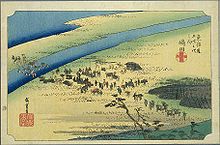- Shimada-juku
-
 Shimada-juku dans les années 1830, estampe d'Hiroshige de la série Les Cinquante-trois Stations du Tōkaidō
Shimada-juku dans les années 1830, estampe d'Hiroshige de la série Les Cinquante-trois Stations du Tōkaidō
Shimada-juku (島田宿, Shimada-juku?) était la vingt-troisième des cinquante-trois stations du Tōkaidō. Elle est située à Shimada, préfecture de Shizuoka au Japon.
Sommaire
Histoire
Shimada-juku était située sur la rive gauche (du côté d'Edo) de la rivière Ōi-gawa, juste en face de Kanaya-juku, la station voisine. Le Shogunat Tokugawa avait expressément interdit la construction de tout pont ou service de ferry sur la rivière, forçant les voyageurs à patauger dans les bas-fonds. Mais quand la rivière était en crue à cause de longues ou fortes pluies, le passage en était presqu'impossible. Durant les périodes de longues pluies, les visiteurs étaient souvent contraint de rester plusieurs jours à Shimada-juku, ce qui augmentait leurs dépenses.
Un diction à propos de Shimada-juku était « Tu peux parcourir les 8 ri vers Hakone, mais pour y parvenir, tu dois traverser l'infranchissable rivière Ōi-gawa» (箱根八里は馬でも越すが 越すに越されぬ大井川 , Hakone hachiri wa uma demo kosu ga / kosu ni kosarenu Ōigawa?)[1].
La classique estampe ukiyoe d'Ando Hiroshige (édition Hoeido) de 1831-1834 montre des voyageurs traversant les bas-fonds et bancs de sables de la rivière. Certains sont à pieds, d'autres portés par des serviteurs et d'autres enfin dans des kago.
Stations voisines
- Tōkaidō
- Fujieda-juku - Shimada-juku - Kanaya-juku
Bibliographie
- Carey, Patrick. Rediscovering the Old Tokaido:In the Footsteps of Hiroshige. Global Books UK (2000). ISBN 1901903109
- Chiba, Reiko. Hiroshige's Tokaido in Prints and Poetry. Tuttle. (1982) ISBN 0804802467
- Taganau, Jilly. The Tokaido Road: Travelling and Representation in Edo and Meiji Japan. RoutledgeCurzon (2004). ISBN 0415310911
Notes et références
- Shimada-juku. Asobiba.
- (en) Cet article est partiellement ou en totalité issu de l’article de Wikipédia en anglais intitulé « Shimada-juku » (voir la liste des auteurs).
Wikimedia Foundation. 2010.
